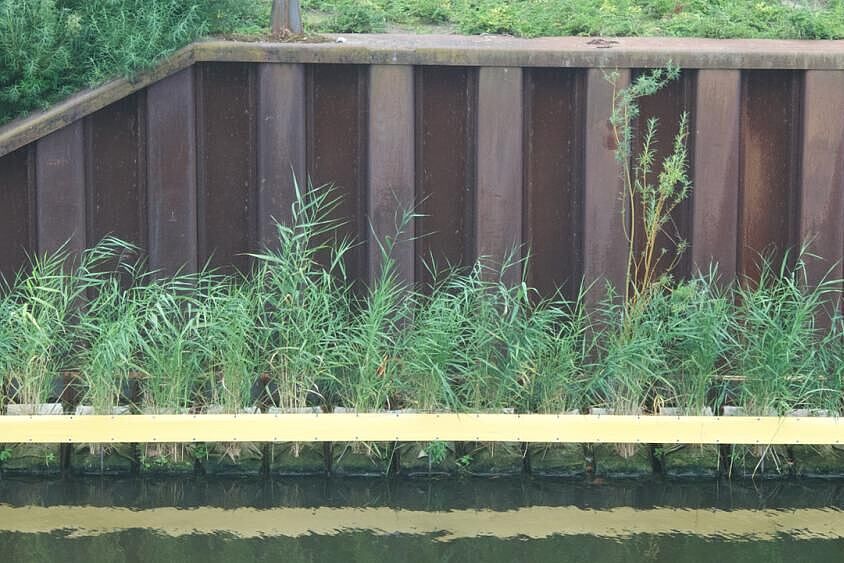Vertical wetlands - the green building block between blue and grey

The picture shows a section of the pilot plant in Berlin | Photo: Ralf Steeg.
There are hardly any near-natural banks and shallow water zones along urbanised rivers and canals. Instead, steep bank reinforcements made of concrete, steel or bricks separate the water from the formerly natural banks for many kilometres. This hard demarcation means that banks and shallow water zones are missing as important habitats for many plants and animals. Therefore, the Leibniz Institute of Freshwater Ecology and Inland Fisheries (IGB) has developed so-called „Vertical Wetlands" together with the specialised engineering company WITE GmbH. These planting modules offer a transferable and scalable option for creating minimal habitats along non-natural and artificial waterways that provide ecological stepping stones for various species and thus enable them to stay and migrate. The principle was successfully tested with the pilot plant in the Berlin-Spandauer-Schifffahrtskanal. The freely available publication format "IGB Manual" gives interested parties and authorities an insight into the construction method and authorisation requirements.
"The strength of the Vertical Wetlands lies in starting where restoration is not possible due to intensive use or dense development. Key green building blocks are offered for this purpose, which help to reduce the major ecological deficits even in relatively small areas," says IGB researcher and project leader Dr Christian Wolter, explaining the basic idea. In this way, sections of waterways can be ecologically upgraded quickly and cost-effectively. "Vertical wetlands also make a contribution to water quality: the shading of the bank walls reduces the heat input into the water due to the bank walls being heated by the sun," adds Christian Wolter. In addition to the ecological aspects, particularly valuable in urban, heavily sealed areas: a new, aesthetic landscape element is created that visually enhances the banks.
Harmless building materials in a flexible system
The system consists of two main components: the support rail attached to the bank wall and the plant modules suspended from it. It can be attached to sheet piling, natural stone or concrete walls and consists only of materials that are harmless and biodegradable for bodies of water: untreated steel, rough sawn wood, substrate appropriate to the type of water body, such as sand or gravel, topped with a biodegradable fleece and woody plants and typical plants of water bodies, such as willows, alders, reeds, rushes and bulrushes. In addition, ecologically important deadwood can be attached between, under or on top of the modules.
"The system is very flexible and can be installed at different heights, lengths and angles of inclination from both land and water. This makes it possible to respond very well to different site requirements, for example to official specifications regarding usable and buildable areas or to monument protection requirements. It can also be easily dismantled if necessary," explains Ralf Steeg from the Berlin-based engineering office WITE, which was responsible for the technical design and realisation of the pilot system. The systems are also designed to withstand strong currents, the suction effect of ships and swell. Should major damage occur, for example due to a ship collision, the modules can be replaced individually without great effort.
Berlin pilot plant quickly shows success and is set to set a precedent
The pilot installation, planted with reeds and four different willow species, was installed over a length of 40 metres in the Berlin-Spandau shipping canal, near the Golda Meir jetty. The plant consists of 76 modules and was installed on the water side from a floating work platform within 14 days in April 2023. IGB carried out regular observations during the project to assess the ecological impact of the installation: "The observations showed that the ecological stepping stones were well received. Just a few days after installation, fish spawn was found on the modules, and after a few weeks, coots made their first nesting attempts. After just one month, root beards had already developed, some of which protruded half a metre into the water. These are particularly valuable as refuges for fish, which are also to be supported by artificial stepping stone habitats as they linger in and migrate through urban watercourses. The modules were also colonised by other aquatic plants, mosses and algae. We were also able to observe various dragonflies, beetles, wasps and spiders as well as water snails," summarises IGB project coordinator Rosanna Wiebe.
"The IGB Manual on Vertical Wetlands contains conceptual drawings as well as an implementation plan based on the experiences from the pilot project. With the free publication, we want to raise awareness of the approach, encourage imitation and give interested stakeholders the opportunity to check for themselves at other locations whether vertical wetlands can be installed there," explains Christian Wolter.
Thanks for constructive cooperation and support
The project was realised in close cooperation with the Waterways and Shipping Authority, the Senate Department for Mobility, Transport, Climate Protection and the Environment and the Mitte district. "I am very grateful for how constructively and successfully everyone involved has worked on this process," emphasises Christian Wolter.
The project was supported by the Berlin Programme for Sustainable Development (BENE) with funds from the European Regional Development Fund (ERDF) and the State of Berlin.






